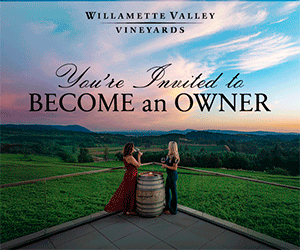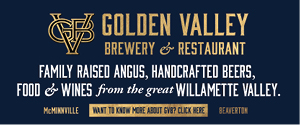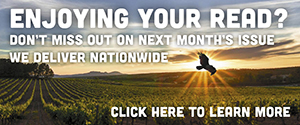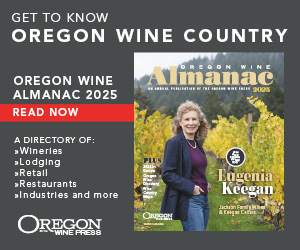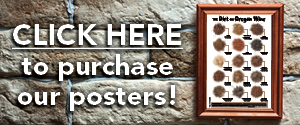Easy Pickings
Learn how Cougar Crest Estate Winery maintains its legacy of fine wines using evolving mechanization
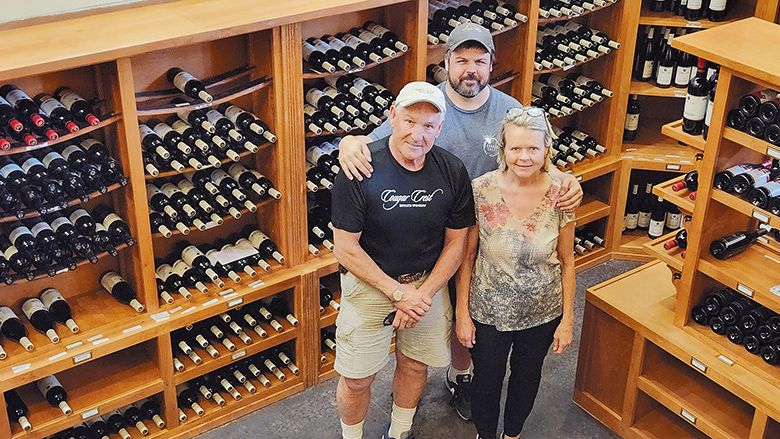
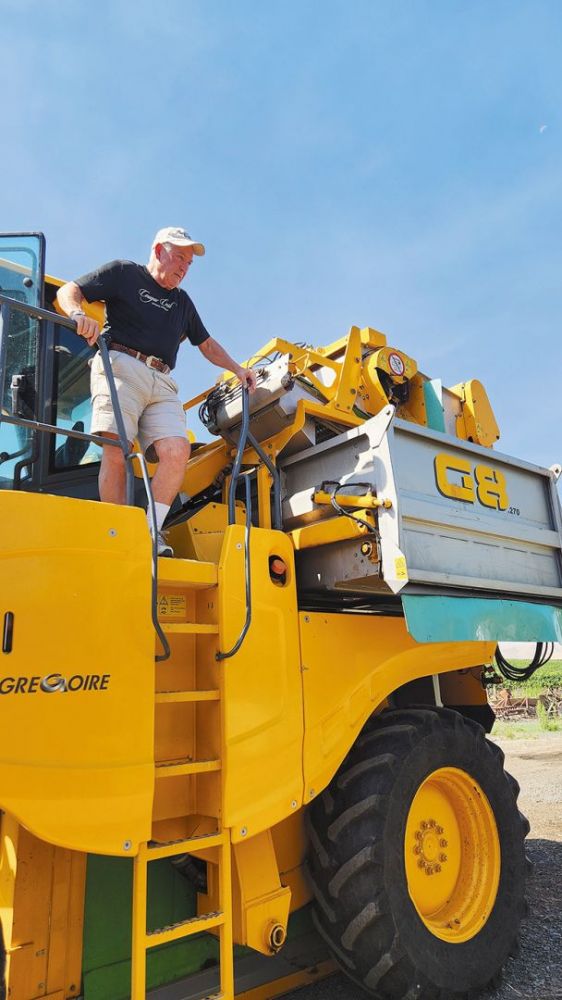
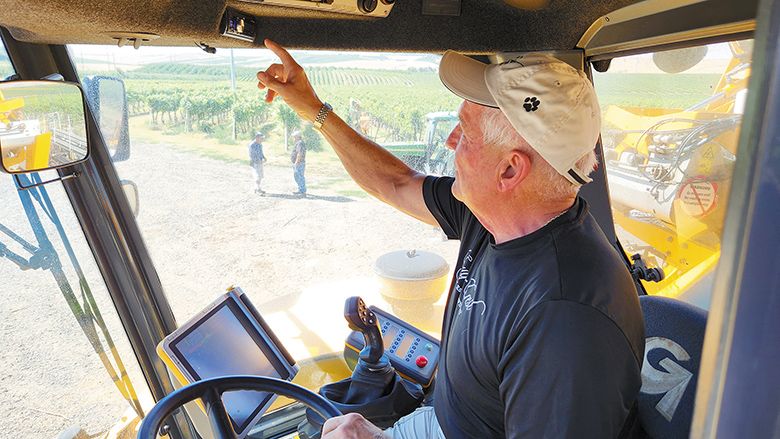
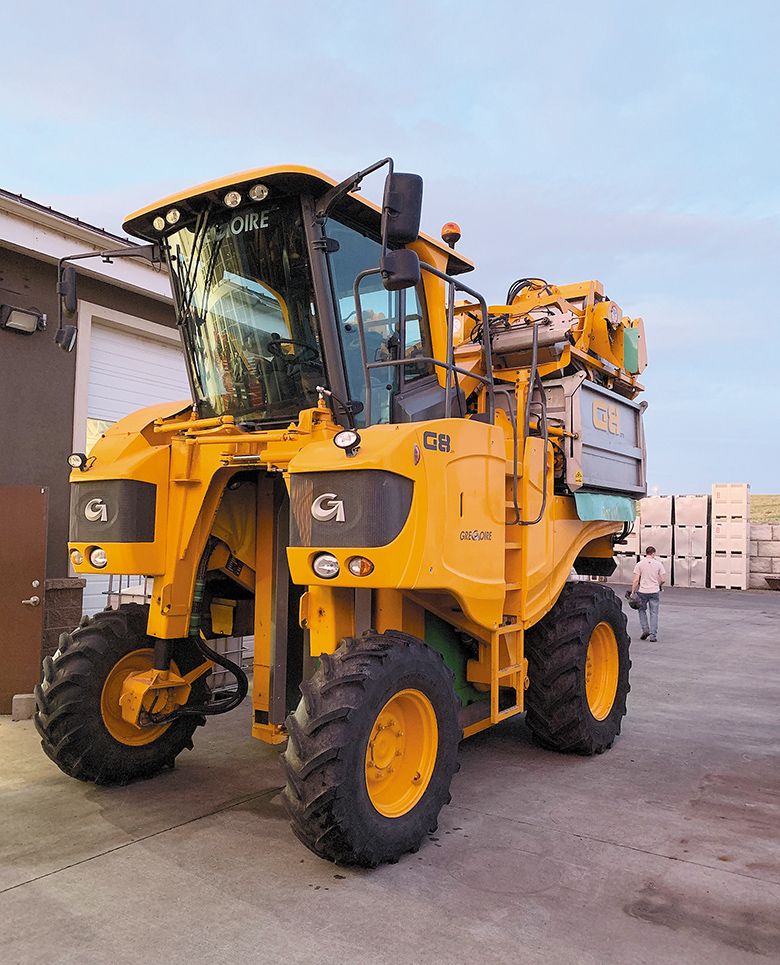
By Sheila Hagar
A dozen feet high, Dave Hansen resembles a grand wizard in the cab of his Gregoire G8.270 grape harvester.
With the morning already on its way to sweltering levels in his Milton-Freewater vineyard, Dave flips on the air conditioning, recalling when this was unheard of in farm equipment. The overall control system, though, is the real star inside the harvester’s cabin.
Curved windows provide all-around visibility, and an armrest-integrated joystick and touchscreen display place every function at the operator’s fingertips. From running conveyor belts to engaging picking heads and loading fruit into waiting bins, everything requires a mere push.
Deciding to invest in the grape harvester wasn’t based on the “cool” factors, but on critical ones, explained Dave and wife, Debbie Hansen, founders and owners of Cougar Crest Estate Winery.
While the winery’s production and tasting room facility is on the north side of the Oregon-Washington state line, its three vineyards– Cougar Hills, Noble Rock and Rock Bottom– totaling 110 acres, are minutes from the small agricultural town of Milton-Freewater to the south.
Cougar Crest produces more than 20 different varieties grown in both the Walla Walla Valley and The Rocks District of Milton-Freewater appellations. Additional tasting rooms are located in Woodinville, Spokane and Lake Oswego.
Transporting grapes 15 minutes from sun-warmed vineyards to cool production space is best done in the early morning hours, and the harvester helps immensely with that timeline. It can pick a 5-acre lot in about three hours, Debbie explained, including trips to the winery.
“Now we can process fruit the same day … Very few grapes are held overnight,” she noted. “The harvester picks at a rate faster than I can walk. It would take my crew all day to do that.”
Grape clusters plucked in the morning are processed at a lower temperature, rather than warming in plastic totes on the vineyard ground while awaiting transportation. Warmer grapes are more prone to bacterial degradation, which can lead to oxidization of the juice and wild yeast gaining a foothold, Debbie added.
High-quality grapes, of course, are the heart of everything. The Hansens examine every operational factor, ensuring Cougar Crest, established in 2001, makes the most of their fruit.
The couple has deep roots in research and science after attending Washington State University, where Debbie pursued a degree in pharmacy science and Dave studied veterinary medicine. Upon graduation, they established careers in the San Francisco area.
In 1996, the family moved to Walla Walla after purchasing land and developing apple orchards. The Valley, home to seven wineries, was growing and producing stellar wine, convincing them to replace some aging apple trees with grapes.
Fifteen years ago, they examined harvesting challenges under the microscope. The price per ton had risen to roughly $38 per hour for each picker, Dave recalled. And that was if they could gather enough workers for the job.
As an estate vineyard, Cougar Crest produces 9,000 cases annually. Half of the 275 tons of harvest is sold to other wineries as grapes or finished wine. Getting enough pickers is always an issue, one becoming increasingly difficult, the Hansens emphasized.
“During grape harvest, because we are small, we compete with other crops. We might only be able to keep a picking crew busy for two or three days before laying them off for a week,” Debbie shared. “No one wants to be off… they want to make money. So they find work at a 400-acre apple orchard and are lost to us.”
Fewer folks are migrating from crop to crop, and the math is simple. “There aren’t enough people for all the crops this country grows,” Debbie added. “The fruit ripens when it ripens, and if I can’t get it picked… the writing is on the wall, you better have a Plan B.”
But moving from mankind to machine also meant parting with tradition in the Walla Walla Valley, naysayers told the winemakers.
Italian immigrants brought farming experience and skilled winemaking to the area in the 1800s, leading to the many wineries and vineyards 150 years later, according to HistoryLink.org, an online encyclopedia of Washington state history.
Growing grapes is farming. Much like when motorized tractors were introduced in the early 1900s, farmers today continue to adopt technology both for need and growth.
Some people opined mechanized picking would reduce the quality of Cougar Crest’s wines, yet the opposite occurred.
After extensive research, Dave found Gregoire’s grape harvester most suited for their vineyards’ vertical-chute trellising. Cougar Crest’s first machine, purchased in 2010, was well-used and lacked some features. More importantly though, it was affordable.
Fast forward eight years to when a newer model was available in Canada. The government there encourages farmers to invest in newer equipment through incentives, so trade-ins are plentiful and in better condition, Dave explained.
The 2015 G.8 270 appeared new upon arrival… and with its German-made Deutz six-cylinder engine, it could outlive him, he noted, laughing.
Everything in the updated Gregoire is an improvement over the first machine.
Within the comfortable cab, Dave explained the many time- and fruit-saving features aiding him in picking and delivering 10 tons of fruit without any extra debris.
The whole operation depends on movement, and lots of it.
As the harvester smoothly straddles a row, it removes clusters from the top down. The double shaking system doesn’t break vines or cause other damage, Dave observed.
From the belly of the machine, rods shake the plants, dropping the fruit onto conveyor belts– which resemble spinning thread spools– that ferry the load into bins on either side. A fan system blows out the sticks, leaves and long grass once sorted out by hand.
“It used to be, everyone in the winery had to drop whatever they were doing and come outside to sort,” Debbie recalled.
When full, the internal bins extend to offload onto trucks. The grapes are then driven to the winery for processing.
The harvester has independent adjustable height on either side, supplying stability on the hillsides. It can turn on a dime and is incredibly maneuverable for such a large machine.
As for the quality of the fruit, no one need rely solely on the Hansens’ word. Besides the umpteen awards garnered since 2003– starting with their debut wines– Debbie was recognized as one of this year’s Washington State/Seattle Wine Awards “Fantastic Four” Winemakers. The organization also granted gold medals to Cougar Crest’s 2021 Cabernet Franc, 2020 Merlot, 2021 Cabernet Sauvignon, 2020 Reserve Cabernet Sauvignon, 2021 Block 11 Syrah and 2021 Anniversary Cuvée.
The Hansens raise a glass to innovations allowing them to pursue continued excellence. By embracing mechanization, they solved labor shortage issues while providing exceptional products to their customers. And that’s the bottom line, they say.
“The grape harvester really has saved us,” acknowledged Debbie.
Cougar Crest Estate Winery
50 Frenchtown Rd., Walla Walla
Open daily 10 a.m. to 5 p.m.
310 N. State St., Suite 108, Lake Oswego
Wed. – Fri. noon – 6 p.m., Sat. – Sun. 11 am – 6 p.m.
www.cougarcrestwinery.com
Sheila Hagar lives with her farmer spouse in Eastern Oregon, writing and reporting for a variety of organizations, businesses and media outlets. She began her writing career as an occasional columnist for publications such as the Chicago Tribune and The Oregonian. Hagar then reported for the Walla Walla Union-Bulletin newspaper for 25 years. She buys wine from Grocery Outlet.



